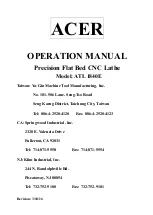
________________________________________________________________________________________
www.wnt.com
XND.00004.023_A - 02/2018
19
3.1
Applications
3.1.1
Adjusting the clamping range
Move the carriage into position for the desired
clamping range.
Insert locking pin (pos. 60) through the matching
hole in the base plate and secure with nut. (pos. 30)
Important:
with the HDG2 160 it is preferable to use the rear
hole since the clamping force is reduced by 20%
when using the front hole. To achieve the largest
clamping range, switch over to the front hole.
3.1.2
Clamping
Use the knurled knob to adjust the required
clamping force.
Before clamping the workpiece ensure that the vice
is securely fixed.
Insert the workpiece.
Turn the crank to adjust the carriage until resistance
can be felt and the coupling disengages.
By continuing to turn the crank up to the stop, high
pressure tension is built up.
When the clamping lever noticeably reaches the end
stop, clamping has been completed and the
clamping force has been mechanically secured.
One crank revolution is required for the clamping force on HDG2 100 and 125.
For HDG2 160 is 1.5 crank revolution required.
Caution:
Continuing to turn forcefully will impair precision and leads to faults. Never use a
hammer!
3.1.3
Releasing
Turning the crank to the left will first reduce the clamping force and then retract the carriage.
3.2
Function
The HDG2 is a quick-release vice. It is mechanically driven by a hermetically sealed spindle
assembly. The force is generated purely mechanically with the help of a mechanical force
element.
The clamping range depends on the size of model and the jaws used.
Knurled knob





































